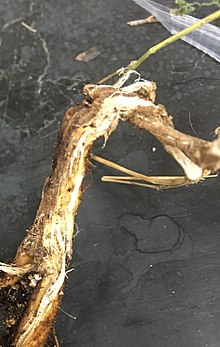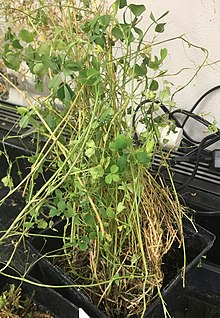Clavibacter insidiosus: Difference between revisions
No edit summary |
{{draft |subject=natural sciences}} |
||
| Line 1: | Line 1: | ||
{{draft |subject=natural sciences}} |
|||
{{AFC submission|t||u=Karalynne32|ns=118|demo=|ts=20191211150236}} <!-- Do not remove this line! --> |
{{AFC submission|t||u=Karalynne32|ns=118|demo=|ts=20191211150236}} <!-- Do not remove this line! --> |
||
Revision as of 19:37, 15 December 2021
This article, Clavibacter insidiosus, has recently been created via the Articles for creation process. Please check to see if the reviewer has accidentally left this template after accepting the draft and take appropriate action as necessary.
Reviewer tools: Inform author |


Clavibacter michiganensis subsp. insidiosus causes bacterial wilt with its most notable host being Medicago sativa (alfalfa). Other species in the Medicago genus are also known to be hosts such as Medicago falcata. Additionally, Lotus corni-culatus, Melilotus alba, Onobrychis viciifolia, and Trifolium sp. are known hosts3. Plants like alfalfa are often mowed, and thisz causes cut stems. The cut stems increase disease susceptibility be providing wounds for the bacteria to enter4. Clavibacter michiganensis subsp. insidiosus causes a systemic disease: the leaflets curl up, an indicative symptom of this disease3. Occasionally, it causes necrosis of the leaflets4. Yellowing of the plant and yellow-brown roots often occurs. This disease is either fatal or causes severe damage to the host with the bacteria leading to stunted growth4. Clavibacter michiganensis subsp. insidiosus needs to be cultured from the infected plant tissues and PCR-tests must be run to confirm a diagnosis4.
Clavibacter michiganensis subsp. insidiosus is typically dispersed by the moving of hay between different agricultural sites. Farm equipment that is not properly sanitized can also spread the pathogen. Water is known to move the bacterium2; if an area in not irrigated and there is low rainfall, the disease will usually not be present4. Plant wounds, specifically on the stem or roots, increase disease susceptibility2 (because there is now wound for the bacteria to enter4) and are often made by mowing, nematodes, or insects. Stem nematodes often act as a vector. They can carry the bacteria on their surface2. If the plant is infected by root-knot nematodes, bacterial wilt is more likely and typically more severe4. Infested soil can additionally cause disease5. A small number of diseased plants (about 6.3-7.7%) can transmit the bacterium to their seeds6.
Disease management of bacterial wilt is critical. One crucial way to control the disease is plant resistance. Finding and then growing only resistant plants will limit the bacterium’s ability to spread1. Plants that can winter well tend to be more resistant5. If susceptible plants are grown, there should be a two-year crop rotation with cultivation5 (cultural management) and herbicide4 (chemical management). There are many methods of cultural management to control bacterial wilt. Some countries require crop inspection in order for seed to be moved4. Additionally, it is important to keep seeds with the pathogen away from areas where bacterial wilt is not present5. The bacterium can be transferred on a variety of farm equipment so the equipment should be cleaned very regularly4. If plants need to be cut, they should do so when they are dry because the bacterium moves in water. Furthermore, plants that are younger and/or resistant should be cut prior to the plants that are older and/or susceptible to prevent disease. Due to the bacterium’s affinity for water, any irrigation used should be carefully monitored to prevent any excess water5. This all helps to prevent the epiphytic phase of the bacterium.
References
1. CABI, and EPPO. “Clavibacter Michiganensis Subsp. Insidiosus.” EPPO Global Database, gd.eppo.int/taxon/CORBIN/documents. 2. EFSA. “Scientific Opinion on the Pest Categorisation of Clavibacter Michiganensis Subsp. Insidiosus (McCulloch) Davis Et Al.” EFSA, John Wiley & Sons, Ltd, 11 Dec. 2014, efsa.onlinelibrary.wiley.com/doi/epdf/10.2903/j.efsa.2014.3910. 3. “PM 7/99 (1): Clavibacter Michiganensis Subsp. Insidiosus.” Wiley Online Library, John Wiley & Sons, Ltd (10.1111), 15 Nov. 2010, onlinelibrary.wiley.com/doi/epdf/10.1111/j.1365-2338.2010.02408.x. 4. Rhodes, Landon H, and William o Lamp. “Bacterial WiltLa.” Compendium of Alfalfa Diseases and Pests, by Deborah A. Samac, third ed., American Phytopathological Society, 2015, pp. 62–63. 5. Samac, D. A., et al. “CHAPTER 16: Detection of Clavibacter Michiganensis Subsp. Insidiosus in Alfalfa Seeds.” Detection of Plant-Pathogenic Bacteria in Seed and Other Planting Material, Second Edition, 2017, pp. 103–107., doi:10.1094/9780890545416.016. 6. Samac, Deborah A, et al. “Transmission Frequency of Clavibacter Michiganensis Subsp. Insidiosus to Alfalfa Seed and Identification of the Bacterium by PCR.” Plant Disease , vol. 82, no. 12, Dec. 1998, pp. 1362–1367., doi:10.1094.

